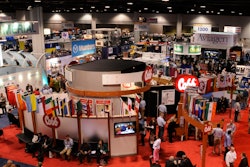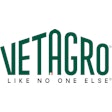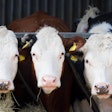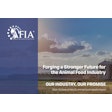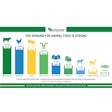Auburn University’s College of Agriculture has hatched an exciting new addition to its poultry science department. Just in time for the fall semester, the long anticipated Poultry & Animal Nutrition Center has opened its doors to students and the poultry industry alike. Located in the center of the “Broiler Belt” (Alabama ranks third in broiler production after Arkansas and Georgia), Auburn is one of six poultry science programs in the United States; the mill is poised to fill the gap in feed and animal nutrition research, training and education in the South.
In January 2008, the seed for the creation of the feed mill was planted in Atlanta at the International Poultry Expo/International Feed Expo (IPE/IFE). Like so many attendees, Auburn University staffers were walking the show, viewing the best the feed and poultry industry had to offer by way of innovation and equipment. Mitchell Pate, director of Auburn University’s Poultry Research Unit, happened upon T.E. Ibberson’s booth and a video of what at the time was Cal-Poly’s new academic feed mill. Impressed, he brought Dr. Don Conner, department head and professor, Auburn Poultry Science, over to learn more about the Cal-Poly project.
“The need was clear-cut — we needed a new mill in order to expand our research capabilities — but what really struck me was the Cal-Poly photo of all the students hanging out on the modular units of its feed mill,” Conner says. “[The design] is ideal for student learning.”
Meanwhile, back at Auburn, the university had been eyeing the prime campus real estate being occupied by the outdated poultry barns and feed mill. Pate, who graduated from Auburn’s Poultry Science program in 1984, returned to the university after years in the poultry industry, before heading up Auburn’s Poultry Research and Extension Center in 2006. One of his primary responsibilities with the university was to spearhead the management the university’s relocation of its poultry farm to the North Auburn Campus; the new feed mill is the first phase of three-part relocation process: phase two, broiler houses and phase three, the processing plants.
Without having much of a plan in place, the supplier community and industry stakeholders, many of whom would eventually become key donors, strongly encouraged the team to bring something similar to Auburn.
“One of my passions is feed milling so I pushed in our department and with the deans to get the ball rolling on the new mill,” Pate says. “I feel like we don’t train students in the feed milling area as much as we should be — especially here in the South. Given the demand, we can help the industry by having more training in the Southeast because if you look at where we are located, we’re in the center of poultry production; regionally speaking, [Auburn] will be the game.”
After years of planning, the school broke ground on the new facility with T. E. Ibberson Company providing the design engineering and Gaylord Construction conducting the construction and erection of the 12,000-square-foot mill which includes a laboratory, demonstration spaces and houses 96 tons of storage.
With the support of the university and private industry, construction on the new mill began in June 2011. One hundred percent of the research mill is funded by soft money from the poultry industry and associated industries who have funded the $7 million research laboratory. No federal or state government money was used to construct this facility. In the end, over $750,000 worth of equipment was donated.
Creation of an academic mill
While the original mill served its purpose churning out generations of Auburn poultry science students, the program’s existing feed mill, erected in the late-’70s, bears no comparison to the new mill.
“It’s like comparing a caveman’s stone wheel against a Mercedes C-Class,” Pate explains.
Conner adds: “The suppliers of the basic equipment are still in business and the tried-and-true technology is there, but the old mill had its limitations. To achieve the level of precision and accuracy for modern poultry and animal nutrition research, we really had to build some more capacity and capability in. The new facility is a whole different ball game.”
To ensure the project was headed in the right direction during the planning phase, the Auburn team formed a technical advisory committee (TAC) comprised of industry leaders and staff to steer the layout of the mill toward an optimal design, including state-of-the-art technologies and the equipment a student will likely encounter in a modern commercial mill.
Similar to the Cal-Poly mill, the committee decided the modular design, [definition here], was the way to go because it offers the right sized workflow for an academic and research extension feed mill.
“The committee insisted we downsize mill to produce batches as small as 250 pounds because a student operating at a small scale can easily adjust the equipment or formulation and see what happens as a result of the adjustment,” explains T.E. Ibberson’s Gerry Leukham. “It is important to be able to make continuous production runs in order to feed the livestock on campus as well as have the ability to slow down to make very precise formulated diets for doing cutting-edge research.”
The mill is equipped with the ability to pregrind, post-grind and hybrid grind ingredients. The nominal capacity of the research feed mill is 5 to 10 tons/hour with a pelleting capacity of 2 to 5 tons/hour.
To translate to real life scenarios, every piece of equipment in the mill is scalable by a factor of 10, 12, 15 — with the same pinch points, same rolls, same dye thickness — so the same test can be run in a larger mill.
“The feed mill runs the same as a full-sized commercial mill… on an itty-bitty scale,” Pate explains. “Nothing has changed. We just have mini versions of the equipment found in a traditional mill.”
Learning from experience
The goal of the new mill is giving the students hands-on experience so they graduate with the ability to connect the dots between production, problem solving and economics to become the future business leaders of the poultry industry.
With oversight by Auburn professors, students will be running the mill: turning equipment on and off, filling the scale hoppers, filling the micro scales, turning on pellet mill, adjusting steam pressures so they will know how a real plant operates when they leave here and they will actually have to manufacture feed.
“The equipment utilizes Plexiglas wherever appropriate so the student’s can actually see the inside of the machine to see what it’s actually doing,” Pate says. “Students making the feed will be able to see what the machine is doing. This is computer-based, automated system so they can observe it on the screen and then be able to walk out and touch it.”
Through lab experiments and assignments, regarding quality issues, Conner hopes students will learn to troubleshoot to make cause-and-effect connections between, for example, the feed conversion rates produced by high-quality vs. low-quality pellets: “If a student can feed birds pellets with different formulas side-by-side and see that performance in the birds, suddenly, the light bulb goes off. You can try to explain something, but when they see it with their own eyes and weigh the chicken then they really understand.”
“Roughly 60% to 70% of the cost in producing a broiler comes from feed milling; so if we can reduce that cost for broiler companies, we’ll be able to save them lots of money,” Pate says.
Sixty graduate and undergraduate students will be using the mill this year. Pate employs 10 to 15 of these students to work at the mill and on the research farm. The program will have some labor at the mill — producing feed for the university’s animal population — but most feed will be made in class.
“We’re hoping to be able to pull from the other animal science departments within the university to create a feed milling program everyone will be able to use,” Pate says. Initially, the mill will solely produce poultry feed; however, the mill has the ability to manufacture additional varieties of feed.
Investing in the future
In general, Auburn positions its students leaving with a broader understanding of the poultry industry to make graduates marketable.
“It seems animal agriculture as a whole missed a generation of hiring so there’s a large gap of middle management,” Conner explains. “The demand for managers, the succession of leadership and a lack of people in the pipeline to take on decision-making roles will become a major issue in coming years. We need to put out students who are well trained in soft skills as much as technical skills so they are able to become industry leaders. I’m not recruiting students to take management positions; I want to put out CEOs and VPs — that’s what we’re training and growing here.”
In addition to cultivating the industry’s future employees, Auburn welcomes private industry to conduct proprietary research at the new facility.
From a continuing education standpoint, Conner feels there aren’t enough hands-on training programs in industry, but the new mill is poised to become a good place to develop middle management with potential to develop their understanding of feed milling and new technology.
“Auburn Agriculture’s bread and butter is serving the poultry industry; that’s our mission to do research and training that is transferrable directly into industry practice,” Conner explains.
Conner notes research is expensive, and the department is not in it to profit, but it does have to cover its costs and reinvest.
“[The mill] was built from donated funds and so without industry connection and the faith the industry has that we will deliver on our promises is how this is being build,” Conner says. “It’s going to be a busy place.”
To date, the school has reached 40% of its funding goal. Dr. Conner invites anyone in the industry who is interested in the mill to come out and take a tour; he also wanted to stress this final message: “We’re still fund raising!” ?




